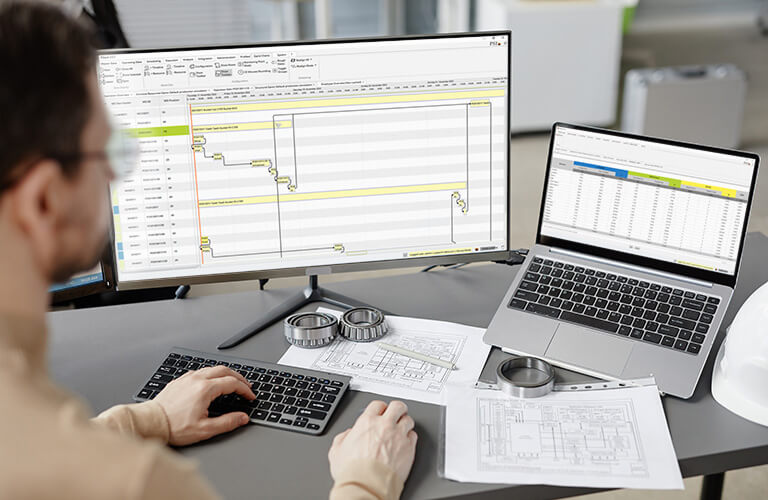What is an APS system?
APS (Advanced Planning and Scheduling) is production software used for planning and scheduling production orders. Thanks to advanced algorithms, the software can create a schedule very quickly, taking into account the capabilities of resources, including the production capacities of machines and equipment. This can significantly reduce the time planners have to work.
What are MES and SCADA systems and how do they manage the production process?
The MES (Manufacturing Execution System) system is used to communicate (e.g. APS) with the production area. Its task is to collect real-time data on the status of production order implementation directly from the hall. Information on the progress of the production process is available on demand, from any place and device, so that production managers and directors have the set of information necessary to make business decisions. The SCADA (Supervisory Control And Data Acquisition) system monitors, controls and collects data from production machines and equipment. The collected data, thanks to visualization, is presented to system users. Thanks to this, SCADA enables a quick reaction to the detection of possible malfunctions in the operation of a machine (failure), or manufactured product, reporting failures and quick reaction to them. Thanks to the collected data, it is possible to optimize the use of available resources, improve the quality of orders and thus effectively manage production.
How to choose the right, effective APS planning software?
Investing in an IT tool for production planning and scheduling gives you a chance to increase production efficiency and quality while saving the time of people involved in this process, as well as minimizing the risk of making mistakes. The key here is that the schedule is created quickly using APS, following established planning algorithms, and based on necessary and available data, including correct technological data. In addition to focusing on resources in the form of machines and operators, a functional APS should take into account production technology, inventory levels, raw material consumption, production technology or delivery date restrictions for materials or components when scheduling. In addition, a clear visualization in the form of Gantt charts is also important - an important planning tool. When choosing the right APS software, key aspects will be: modern application technology, user-friendly interface, ease of integration and, in many cases, above all, the supplier having an experienced implementation team committed to developing the concept and implementing the solution.
Does a company need APS production planning software if it already has an ERP system?
ERP and APS fulfill separate tasks. ERP is an enterprise management system that digitizes the handling of processes operating in a given organization, from administrative processes, through warehousing to production. It is used for rough resource planning and used by companies from various industries. Due to the general nature of this solution and its versatility, it may prove insufficient. In such a situation, it is worth considering investing in an advanced, dedicated system that will fill the gap between ERP and the production hall. These systems have been created with the idea of solving specific production issues. In the case of APS, these relate to the issues of planning and scheduling production orders. Does this mean that ERP and APS systems are mutually exclusive? In principle, ERP and APS systems should work together. The ERP has, among others, data related to the scope and deadlines of customer orders, planned raw material and material deliveries, inventory levels, machine fleet, expected implementation dates, etc. In turn, APS uses information from ERP, based on the current, importantly real production situation conveyed by MES systems, using advanced planning algorithms, generates a detailed schedule for the implementation of production orders. In this way, the production process can be optimized, and thus shorten implementation times and reduce order execution costs.
What benefits does the implementation of the PSIasm production management system bring?
The modern PSIasm system combines three modules that allow comprehensive management of the entire production process. APS, responsible for planning and scheduling, MES related to reflecting the real production situation and SCADA responsible for acquiring data from machines and devices. The integration of APS with production execution systems (MES and SCADA) makes it possible to track the actual process of executing production orders in real time and compare the results with the schedule. The complete picture of the situation allows quick reaction to production events such as unplanned downtime and priority changes. As a result, PSIasm makes it possible to reduce production costs by up to 20%, as well as improve the timeliness of deliveries. Our software also helps save employee time and maximize production capacity and available resources, thus providing the ability to increase production efficiency by up to 10%. PSIasm also enables analysis of key production efficiency indicators through dedicated OLE and OEE reports. Additionally, at every stage of the project, the client can rely on comprehensive support from the experienced team of software supplier - the PSI team.
Who is the PSIasm production management system intended for?
Our software is intended for both large, medium and smaller companies. To meet diverse needs, we offer two implementation paths. For companies with a smaller number of machines, devices and active operations up to 50,000 per month, we propose the Quick Start path. It is based on the standard system configuration and can be implemented in as little as 3 months. On the other hand, for larger companies, achieving over 50,000 active operations within a 1-month horizon and at the same time expecting an individual approach and dedicated solutions, the Enterprise path is recommended.
How does PSIasm stand out from other, similar solutions?
PSIasm is the only platform that combines APS, MES and SCADA solutions. Automatic production planning in the system and control of its implementation are possible thanks to advanced algorithms using artificial intelligence and machine learning mechanisms. By choosing PSIasm, you choose an integrated platform that enables efficient production management using one tool from one place. An important advantage is the functionality of the interface and the use of click-design technology, which allows views to be customized to your needs. Production management becomes exceptionally simple and transparent thanks to this, and the user has the information necessary to make key decisions at hand.
How much does the implementation of production management software cost?
The costs of implementing such software depend on many factors, such as the size of the enterprise, the complexity of production processes, and consequently the scope of functionality of the selected solution. Not only the costs of purchasing licenses and implementation should be taken into account, but also any modifications related to adapting the solution to unique processes. Overall, a production management system is an investment from several tens to several hundred thousand zlotys.
What conditions must be met to implement the PSIasm production management program?
In order to implement the PSIasm program, the company must first have the appropriate IT infrastructure and technological data. Therefore, information about the amount of processed data is crucial in order to select servers with sufficient computing power and appropriate terminals - in the case of implementation of the MES module. A prerequisite is the preparation of complete and correct data on production orders, production technologies, routes, BOMs, etc. Effective implementation of the software also requires close cooperation between the supplier of the ERP system, the partner implementing the PSIasm software, and the customer, as well as training of employees in the use of the system.
How can your company prepare for implementation?
To properly prepare a company for the purchase of a modern production management system, it is worth analyzing and optimizing existing production processes and the quality of existing data. Therefore, the completeness of the data on resources, products, technologies, as well as the flow of information on production registration should be verified. A good solution is also the gradual digitization and automation of processes.


